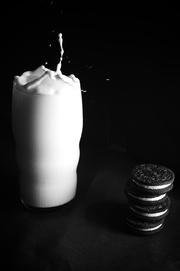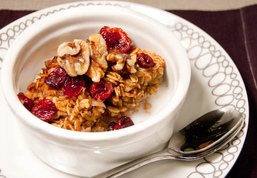 Building Strong Bones Takes More Than Just Calcium One of the most common concerns I hear from people when they would benefit from avoiding dairy products is the fear of missing calcium. Calcium is an important mineral, but to build strong bones and healthy teeth it takes more than just calcium to achieve it. Also, dairy products, like cow's milk, are not the only source or even the best source of calcium. Foods with Calcium Food sources: Tahini or sesame seed butter, almonds (powerhouse of calcium), salmon and sardines (with bones), soy, navy beans, blackstrap molasses, amaranth, broccoli, and kale. Almost all leafy greens are high in calcium. Nuts and seeds, deliver more calcium than milk (and usually more absorbable because they’re often raw). Sesame seeds offer 2200 mg calcium per cup vs 228 mg of calcium per cup of milk. One tenth of a cup or 1 ½ tablespoons of sesame seeds, would be the same amount of calcium as 1 cup of milk. Another note on milk, it loses 50% of available calcium through pasteurization. Low fat and skim milk offer even less because the milk fat is used for transportation and absorption of calcium. Making Healthy Bones Main minerals needed for bone building: calcium, phosphorus, magnesium, boron, and manganese, as well as vitamins A, D, C and B12. The hard part of bones store calcium and phosphorus, the bone marrow in the middle makes red blood cells (RBCs) and immune cells, which are made of fat that is stored for energy. The bones are made of a matrix, which is 25% water, 25 % fiber, and 50% mineral salts. The mineral salts of calcium, magnesium, fluoride, and sulfate are deposited between the protein fibers of collagen, and crystalized into salts, making the bone hard. If bones are too mineralized they will become brittle and easily break. In order to make good strong bones, we need all of these things in our diet as well as a good amount of physical activity. The stress of muscles and tendons placed on bones from movement is integral to the balance of building bones. The matrix is in a constant state of building and breaking down, and this process is only performed properly when ALL the building blocks and the right conditions are in place. Foods to Avoid Just as there are good food sources for calcium, there are also foods to avoid. The following foods either decrease absorption of calcium or increase the excretion of calcium: o High caffeine coffee, tea, soft drinks, and chocolate o Sugar is similar to caffeine and decreases the amount of phosphorus in the blood o High phosphorus intake from meat, grains, and soft drinks can take calcium from bones. Phosphorus and calcium need to be in a certain balance to have a positive effect on bone mineralization. o Salt also has similar effects to sugar and caffeine o Low Vitamin D can lead to low levels of calcium o A high fiber diet (with most fiber coming from wheat) can lead to lowered calcium absorption as fiber binds calcium and is excreted from the body o Protein in excess depletes calcium substantially. Too much creates an acidic environment requiring alkaline minerals like calcium to re-establish balance. Junk foods, refined foods, and most cooked foods also have this acid forming effect on the body. Protein also acts as a diuretic in the body, causing the kidneys to send calcium and other minerals out in the urine. A Note about Infants and Children: To help decrease some of your fears for baby, they start off with a calcium store of about 30 g that they get from you mostly during the 3rd trimester (approximately 200-350 mg a day). You can recover most of this loss within a few months following the finishing of nursing by following a calcium-rich diet. Whether you're breastfeeding or formula feeding getting enough calcium is important for you and baby, and dairy is not the only place to find it. General guidelines for protein: There is approximately 0.9 g of protein per 100 mL of breast milk and as breast milk intake decreases, protein content increases. It can be difficult to tell how much the baby is drinking in a day, but generally they get what they need. For formula fed babies, look at the label on the formula. If you're concerned about calcium or the state of your bone health then talk to your Naturopathic Doctor today about putting together a plan that addresses your individual needs. References: Phillipson-Webb, L. 2010. Sprout Right: Nutrition from Tummy to Toddler. Penguin Canada. Romm, A. 2003. Naturally Healthy Babies and Children: A Commonsense Guide to Herbal Remedies, Nutrition, and Health. Celestial Arts. Skowron, JM. 2009. Fundamentals of Naturopathic Pediatrics. CCNM Press. Print.
1 Comment
 Looking for a quick and nutritious breakfast? Try some oatmeal with a little extra flavour with this recipe for blueberry almond oatmeal. The almonds and blueberries add more nutrients and brighten up those plain oats. Be sure to get the thick cut rolled oats as they are processed less than the quick cooking oats. Serves 3-4 2 cups thick rolled oats 4 cups water pinch of sea salt maple syrup or agave nectar blueberries, fresh or frozen raw almonds, ground cinnamon 1. Place oats, water and sea salt into a medium saucepan. Turn heat to medium, cook oatmeal until it begins to bubble then turn heat to low. 2. Continue stirring until oatmeal is thick and cooked, about 10 mins. 3. Grind raw almonds in a coffee grinder to a fine meal. 4. Place desired amount of oatmeal into a serving bowl, top with a little maple syrup or agave nectar, a handful of blueberries, and a tablespoon or two of ground almonds. Sprinkle with cinnamon if desired. Note: If you are gluten sensitive, be sure to check the label that the oats are gluten free. References: Segersten, A. & Malterre, T. The Whole Life Nutrition Cookbook. Blueberry Almond Oatmeal. 2nd Ed. Whole Life Press.  Most of us are feeling at least a little tired of all the snow, and are thinking more and more often about spring and sunshine. However, for some of us the change of season is much more noticeable because of the huge difference it makes in our mood. It’s normal to have a few days of low mood, but if it persists for most of the winter months and you aren’t motivated to do anything you enjoy then it may be something a little bit more. Seasonal affective disorder (also called SAD) is a type of depression that occurs at the same time every year. If you're like most people with seasonal affective disorder, your symptoms start in the fall and may continue into the winter months, sapping your energy and making you feel moody. Less often, seasonal affective disorder causes depression in the spring or early summer. What are the signs of SAD?
If you think you may have SAD it is important that you discuss how you are feeling with your health care provider. SAD is considered a type of depression, which can worsen and potentially lead to thoughts of suicide. If you are having thoughts of harming yourself or others it is of the utmost importance to seek medical help immediately!
What Can We Do About SAD? Light Therapy (phototherapy) has been shown to be a very effective treatment for reducing feelings of SAD. The specialized light box mimics natural light, which seems to have an effect on brain chemistry related to mood. Most people start to respond after 2 to 4 days and causes few side effects. Conventional Treatment: If symptoms are more severe then a combination of psychotherapy and medication (eg. Zoloft or Paxil), may be employed by your doctor. Generally a medication with the fewest side effects will be chosen, and your doctor may suggest beginning the antidepressant prior to the start of your symptoms each year. Naturopathic Treatment St. John’s Wort: has been used to treat mild to moderate depression. Some studies have found St. John’s Wort to be comparable to tricyclic and SSRI (fluxotine) with fewer side effects. SAMe: synthetic form of the same substance that is made naturally in the body from a reaction between methionine (an essential amino acid) and ATP, has been shown to alleviate depression as well as the pain of osteoarthritis. Melatonin. This natural hormone helps regulate mood. A change in the season may change the level of melatonin in your body. Omega-3 fatty acids. Omega-3 fatty acid supplements may help relieve depression symptoms and have other health benefits. Sources of omega-3s include fish such as salmon, mackerel and herring. Omega-3s are also found in certain nuts and grains and in other vegetarian sources, but it isn't clear whether they have the same effect as fish oil. Lifestyle Let the sun shine in: Open the blinds, trim a few branches, add a skylight if need be. Do whatever you can to allow more natural light into the home and office. Go outside: Try and get outside during the day when the sun is shining. Take a nice walk, sit on a bench, just try and get into the natural light more often. Exercise: Regular exercise has been shown through many studies to improve mood and relieve stress and anxiety. Mind-Body Therapy All of the following have been linked to decreased feelings of depression to varying degrees: - Acupuncture - Yoga - Meditation - Guided Imagery - Massage There is no one set formula for preventing SAD, but through proper treatment and working with your health care provider you can learn to manage this condition well. Talk to your Naturopathic Doctor today about getting assessed and treated if needed, and as always talk to your health care provider before beginning any new medication or supplement. References: Godfrey A. & Saunders P.R. (2010) Principles & Practices of Naturopathic Botanical Medicine: Volume I: Botanical Monographs. Central Nervous System, pg. 161-163. CCNM Press. Mayo Clinic. Diseases and Conditions: Seasonal Affective Disorder (SAD). http://www.mayoclinic.org/diseases-conditions/seasonal-affective-disorder/basics/definition/con-20021047 Murray M. & Pizzorno, J.. (1998) Encyclopedia of Natural Medicine (2nd Ed.). Depression, pg 377-400. Three Rivers Press. |
Sarah Connors
I am a Naturopathic Doctor and Doula providing care in the Kitchener-Waterloo area. I have a passion for helping people with their health issues and improving the birth experience for Moms, and their babies. I also have a life long love affair with soccer, curling, and the alto saxophone. Archives
November 2020
Categories
All
|
Photos from Rural Royalty, manu flickr2010, Ryan Dickey, wocintechchat, huskyte77, paulswansen, Black Room Photography, harum.koh, Emery Co Photo, JeepersMedia, BrownGuacamole, wellnesswildflower, JeepersMedia, vastateparksstaff, colindunn, seelensturm, /\ \/\/ /\, 50mm.za, The Simpsons (Lee, Shirley, Luke and Rachel), AGRONAUTI, aivas14, Jonathan Rolande, winnifredxoxo, juhansonin, osseous, nan palmero, Theo Crazzolara, brianfagan, TP studio, wuestenigel, torbakhopper, anka.albrecht, Michael Stern, [-ChristiaN-], franchiseopportunitiesphotos, terren in Virginia, nateOne, barnimages.com, Dun.can, wuestenigel, @lattefarsan, amandabhslater, aphrodite-in-nyc, nutritionaldoublethink, Anne Worner, donnierayjones, mikecogh, angeloangelo, Rob.Bertholf, getaiwan, Lida Rose, matsuyuki, SurFeRGiRL30, marcoverch, amsfrank, mdaltry, nutrition education, Mike Prince, Edsel L, Neighborhood Nini, philipp.alexander.ernst, Mediocre2010, homethods, quinn.anya, Gamma Man, katerha, Eric Kilby, National Institutes of Health (NIH), rcmd_cfdfw_5_2, curtis palmer, Ray in Manila, frankieleon, Airsoftpal.com, byzantiumbooks, cchana, Brian Legate, Matt Lavin, BradHinton, monpetitchouphotography, wuestenigel, alexisjordanlewis, ByEPhotos, erix!, RLHyde, return the sun, quinn.anya, mliu92, frankieleon, loudista, Lyn Lomasi, upslon, derrickbrutel, cchana, National Institutes of Health (NIH), watts_photos, marcoverch, derrickbrutel, francesbean, weegeebored, Airsoftpal.com, Etwood, wu_135, shixart1985, Ingrid Taylar, VeritasFotografie, BioDivLibrary, emmanuelmorales1, Thanks for 1.5 Million Views!!, Will Merydith, reader of the pack, RoxyHobbs, Khanelle Prod' Medias, storyvillegirl, agromonitor, Arenamontanus, six:eleven, cote, SweetOnVeg, nenoirenediaz, lucianvenutian, markhillary, anotherlunch.com, inkknife_2000, archibald jude, rawtrigger, Imaginary Museum Projects: News Tableaus, Pavel P., Courtney Emery, Thien Gretchen, physiognomist, bark, Michigan Municipal League (MML), alberth2, Merelymel13, neofob, Care_SMC, Parker Knight, B*2

 RSS Feed
RSS Feed
